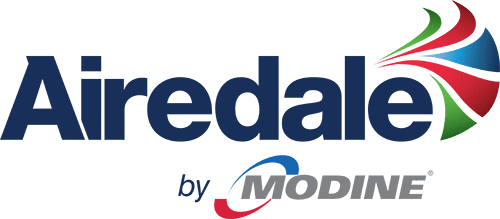Embodied Carbon – Why it Matters for Data Center Sustainability
 As the built environment aims for net zero, attention is rapidly shifting beyond operational energy to include the embodied carbon of products and systems – especially critical cooling equipment, which plays a major role in both construction and long-term building performance.
As the built environment aims for net zero, attention is rapidly shifting beyond operational energy to include the embodied carbon of products and systems – especially critical cooling equipment, which plays a major role in both construction and long-term building performance.
At Airedale by Modine, we’re committed to supporting our customers on their journey to decarbonize buildings. That’s why we’re embracing methodologies like TM65, calculating the embodied carbon of our products, and working toward the development of carbon life cycle assessments (LCAs) and environmental product declarations (EPDs) to drive transparency and continuous improvement.
But what exactly do these terms mean – and why do they matter?
What Is Embodied Carbon?
When we think about carbon emissions in buildings, we often think about operational emissions – those generated from heating, cooling, lighting, and powering a building once it’s in use. Whilst operational emissions have traditionally been the focus of carbon reduction strategies, the landscape is shifting. Globally, the built environment is responsible for around 42% of annual CO2 emissions. Of this total, emissions from embodied carbon are responsible for an additional 15% annually (1).
Referring to the greenhouse gas emissions associated with the extraction, manufacturing, transportation, installation, maintenance, and disposal of building materials and equipment, embodied carbon might seem like a smaller piece of the puzzle, but as the energy grid decarbonizes and buildings become more energy-efficient, embodied carbon will make up a growing share of a building’s total emissions. In fact, by 2050 it is projected that nearly half of the carbon footprint of new construction will come from embodied sources (2).
Unlike operational emissions which are spread over decades, embodied carbon is released right now, and that makes a powerful lever for near-term climate impact. As a manufacturer of critical cooling systems we can seek to take control from the very beginning. Embodied carbon includes everything from the metal in the casings to the refrigerants, circuit boards, and internal components. By taking a proactive approach, manufacturers like Airedale by Modine are enabling clients to make informed sustainability decisions that will shape the future of projects as whole.
TM65: A Practical Approach
Embodied carbon calculations are often complex and data-intensive; that’s where TM65 comes in.
Developed by the Chartered Institution of Building Services Engineers (CIBSE), TM65 provides a consistent methodology to estimate the embodied carbon of building services products when full lifecycle data (like an EPD) is not available. It is ideal for early design stages and requires basic product data.
TM65 allows manufacturers to provide estimated embodied carbon values in the form of kg CO2e for products based on:
- Material composition (e.g., steel, aluminium, copper, plastics)
- Manufacturing processes
- Transport assumptions
- Product lifespan
While not as detailed as a full LCA or EPD, TM65 offers a practical and credible way to share carbon information during early design stages – supporting more sustainable choices.
At Airedale by Modine, we are committed to integrating sustainability into our operations and product development. Whilst the process of compiling complete and verified data is both detailed and time-intensive, we can supply TM65 calculations on a selection of our products and we are working towards this being available across our full product range. We value our customers support as we adopt new environmental practices and would encourage contacting an Airedale by Modine representative for further details.
What is an LCA?
The next step in advancing embodied carbon assessments for products is to move from TM65 calculations to carbon life cycle assessments (LCA), providing a more detailed and comprehensive evaluation of environmental impacts and typically including more detailed, specific data.
Unlike TM65, which focuses solely on embodied carbon expressed in kgCO2e, an LCA evaluates a broader set of environmental indicators. These can include, but are not limited to, global warming potential, resource depletion, acidification, eutrophication and ozone layer depletion. Standards such as ISO 14040 are used to provide methodological frameworks for LCA goal, scope, inventory analysis, impact assessment categories and interpretation.
There are three main different types of LCAs:
- Cradle to gate: Assesses product environmental impacts until it leaves the factory. These LCAs are used to understand upstream production impacts without considering how products are used or disposed of.
- Cradle to grave: Assesses a products entire life cycle from raw material extraction to disposal.
- Cradle to cradle: Assesses product environmental impacts throughout the entire life cycle and takes into accounts for benefits beyond the life cycle such as material reuse and recyclability.
Widely viewed as a cornerstone of environmental management in manufacturing, LCA documentation, for any industry, is not simple to put together due to the complexity of data collection. However, Airedale by Modine believes in sustainable accountability and has already begun the complex journey of data collection. Working towards the provision of LCA documentation across the full product range is something that Airedale by Modine is fully committed to.
What Are EPDs?
An EPD is a third-party verified life cycle assessment that provides a detailed, standardized summary of the environmental impact of a product across its lifecycle. EPDs are developed in accordance with international standards (such as EN15804 and ISO 14025) and rely on LCA studies to quantify impact categories.
The scope of an EPD varies based on product category rules (PCR) – a set of guidelines that ensures consistency in how similar products should be calculated and presented.
A typical EPD includes data on:
- Raw material sourcing
- Manufacturing processes
- Energy use and emissions
- Transportation
- Product lifespan and recyclability
- End-of-life disposal or recovery
EPDs are developed in accordance with international standards (such as EN 15804 and ISO 14025) and rely on LCA studies to quantify impact categories like global warming potential, resource depletion, and ozone formation.
For air cooling systems, producing an EPD can be challenging due to the complexity of components, evolving refrigerant standards, and supplier transparency, but the benefits are significant:
- Transparency: customers can make informed comparisons between products.
- Credibility: third-party verification ensures data accuracy and standardization.
- Compliance: EPDs support green building certifications such as Building Research Establishment environmental assessment methods (BREEAM), Leadership in Energy and Environmental Design (LEED), The Well Building Standard (WELL), and National Australian Built Environment Rating System (NABERS).
- Improvement: manufacturers can identify hotspots and improve designs for lower impact.
At Airedale by Modine, we believe that it’s important to give our clients the right information so that they can make informed decisions. As such, we are embarking on the long and complex journey with our supply chain and data partners to prepare EPDs on future product lines as part of our sustainability journey.
Why This Matters to Our Customers
The drive toward net zero buildings, increasing regulations, the rise of ESG reporting and market drivers all mean one thing: reporting embodied carbon is no longer being considered as an optional requirement. Specifiers, building owners, and consultants are demanding data – and manufacturers have a key role to play.
By adopting TM65 and working towards developing LCAs and EPDs, Airedale by Modine is:
- Helping design teams make lower-carbon product selections
- Enabling compliance with sustainability frameworks
- Contributing to a more transparent and accountable HVAC industry
Whether you’re aiming to gain an accreditation from BREEAM, reduce Scope 3 emissions in your value chain, or simply trying to futureproof your project, understanding embodied carbon is essential.
Looking Ahead
As an industry, harnessing the power of sustainability is key to success in the transformation of how cooling systems are designed, selected, and evaluated. By being better equipped we can make smarter, more sustainable choices at every step of the journey from concept to cooling. As we continue our sustainability journey, Airedale by Modine strives to deliver the right support for our partners, from credible carbon data to innovative low-carbon cooling, and leadership in sustainable manufacturing.
If you’re interested in learning more about TM65 assessments or embodied carbon calculations, get in touch with our sustainability team at [email protected] – we’d love to hear from you.
Let’s work together to build a low-carbon future – one cooling system at a time.
Sources





